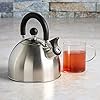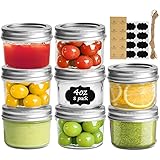T-fal Ultimate Hard Anodized Nonstick Cookware Set 14 Piece, Oven Broiler Safe 400F, Lid Safe 350F, Kitchen Cooking Set w/Fry Pans, Saucepans, Griddle, Dutch Oven, Pots & Pans, Dishwasher Safe, Black
50% OffPrimula Stewart Whistling Stovetop Tea Kettle Food Grade Stainless Steel, Hot Water Fast to Boil, Cool Touch Folding, 1.5-Quart, Brushed with Black Handle
5% OffComSaf Mini Mason Jars 4oz - 8 Pack, Regular Mouth Mason Jar with Lids and Seal Bands, Small Glass Canning Jar for Spice, Jam, Honey, Jelly, Dessert, Shower Wedding Favors, DIY Candles Decor
$12.99 ($1.62 / count) (as of November 13, 2025 12:46 GMT -05:00 - More infoProduct prices and availability are accurate as of the date/time indicated and are subject to change. Any price and availability information displayed on [relevant Amazon Site(s), as applicable] at the time of purchase will apply to the purchase of this product.)Table of Contents
- 1. Keep Your Cast Iron Dry and Well-Seasoned
- 2. Avoid Moisture and Humidity
- 3. Use Proper Storage Solutions
- 4. Ensure Proper Airflow
- 5. Avoid Stacking and Damage
- 6. Regular Maintenance and Re-Seasoning
- 7. Store in a Safe, Accessible Location
1. Keep Your Cast Iron Dry and Well-Seasoned
Proper Drying After Washing
After every use, itâs essential to thoroughly dry your cast iron cookware to prevent rust. Even a few drops of water left on the surface can lead to corrosion over time. I recommend drying your skillet immediately with a clean towel or air-drying it on low heat on the stove. For added security, some experienced cooks prefer to briefly heat the cookware to evaporate any remaining moisture.
In 2025, advances in seasoning techniques mean you can maintain a natural non-stick surface without synthetic coatings. Ensuring your cast iron is dry helps retain its seasoning layer and prolongs its lifespan. Remember, moisture is the enemy when learning how to store cast iron cookware properly.
Maintaining a Perfect Seasoning Layer
Seasoning is what gives cast iron its non-stick properties and prevents rust. When storing, a well-seasoned surface acts as a barrier against moisture and air. To keep your seasoning intact, apply a thin layer of oil after cleaning and drying. This process enhances the skilletâs protective layer and makes it less susceptible to rust during storage.
In 2025, new eco-friendly oils and seasoning products are trending, making maintenance easier and more sustainable. Keep your cast iron in top shape by re-seasoning lightly every few months, especially if you notice the surface becoming dull or sticky. Proper storage starts with a well-maintained, dry, and seasoned skillet.
2. Avoid Moisture and Humidity
Choose a Dry Storage Environment
Humidity is the biggest threat to stored cast iron cookware. In locations with high humidity, even a dry skillet can develop rust if not stored correctly. For 2025, I recommend keeping your cast iron in a cool, dry placeâlike a pantry, closet, or dedicated cabinetâaway from sources of moisture such as dishwashers or humidifiers.
If your kitchen tends to be humid, consider using moisture absorbers like silica gel packs or activated charcoal bags in your storage area. These small additions can make a significant difference in preventing rust and preserving your skilletâs longevity.
Use Desiccants for Extra Protection
In more challenging environments, placing desiccants inside the storage container or cupboard can help keep moisture at bay. Simple, reusable silica gel packs are inexpensive and effective, and many are now non-toxic and eco-friendly. Regularly replacing or recharging these desiccants ensures ongoing moisture control.
By controlling moisture levels, youâre effectively learning how to store cast iron cookware in a way that preserves its seasoning and prevents rust. It’s a small step with a big impact in the long-term care of your cookware.
3. Use Proper Storage Solutions
Choose the Right Containers or Compartments
Storing cast iron cookware in appropriate containers can prevent accidental damage and rust. Opt for open shelving, hooks, or racks designed for heavy pots. Avoid stacking heavy cast iron pans directly on top of each other without padding, as this can damage the seasoning and cause scratches.
In 2025, many new storage solutions are designed specifically for cast iron, including magnetic strips and wall-mounted racks that keep your pans accessible and well-ventilated. These options help maintain airflow and minimize moisture exposure, which is crucial in how to store cast iron cookware correctly.
Use Protective Layers or Liners
To prevent scratches or chipping, consider placing soft cloths, paper towels, or felt pads between stacked cookware. This not only protects the surface but also absorbs any residual moisture, reducing rust risk. When storing individual pieces, keeping them in padded containers or fabric bags can be an excellent safeguard against damage.
Effective storage solutions can extend the life of your cast iron and keep it looking pristine for many years. Properly stored cookware is easier to clean and maintain, reinforcing smart habits around how to store cast iron cookware properly.
4. Ensure Proper Airflow
Why Ventilation Matters
Good airflow is vital for preventing moisture buildup around your cast iron cookware. When storing in enclosed spaces, ensure theyâre well-ventilated. Air circulation helps evaporate any residual moisture and keeps the surface dry, which is essential in how to store cast iron cookware effectively in 2025.
Use open shelves, hanging racks, or racks with gaps that allow air to move around the cookware. Avoid airtight containers or tightly sealed cabinets unless they include small venting options. This way, you prevent trapping humidity that could cause rust and undermine your efforts to maintain your cookware.
Best Practices for Ventilated Storage
Strategically place your cast iron pans away from walls directly against humid areas like the dishwasher or sink. Ensure that storage spots are not enclosed in closed drawers or solid cabinets without ventilation. Regularly check on your storage space to confirm good airflow, especially if you notice any signs of moisture.
Incorporating these airflow principles into how you store cast iron cookware can extend its usable life significantly. Proper ventilation, combined with moisture control, is a key component of effective storage in 2025.
5. Avoid Stacking and Damage
Safe Stacking Techniques
Many cooks love stacking their cast iron cookware for convenience, but this can lead to scratches, chipping, or damaging the seasoning. The key is to use protective pads or cloth layers between pieces. For example, placing a paper towel or soft cloth between stacked pans can prevent abrasion.
In 2025, new innovative stackable systems designed specifically for cast iron are gaining popularity. These help keep your cookware in good shape while maximizing storage space. When stacking, always ensure that heavier pieces are on the bottom to reduce pressure on the delicate seasoning of lighter pans.
Carefully Handling Heavy Cookware
Because cast iron is heavy, lifting or sliding pans improperly can cause chips or cracks. Always lift rather than drag them across surfaces. When storing, place your cookware gently onto shelves or hooks, and avoid overloading racks. Proper handling preserves not only the appearance but also the performance of your cast iron cookware.
Learning how to store cast iron cookware without stacking or with the right stacking method helps prevent unnecessary damage, ensuring your cookware stays functional and attractive for years to come.
6. Regular Maintenance and Re-Seasoning
Consistent Cleaning Routines
Proper storage begins with regular cleaning, especially after cooking acidic foods or when food residue remains. Avoid soap if youâre seasoning your cast iron; instead, use hot water and a stiff brush. Dry thoroughly to prevent rusting before storing.
In 2025, innovative cleaning tools like biodegradable scrub pads and eco-friendly oils are becoming standard. These help keep your cookware in excellent condition, aligning with the trend of sustainable practices.
Re-Seasoning for Longevity
Over time, the seasoning layer can wear thin or become uneven. Periodic re-seasoningâapplying a thin coat of oil and heatingârefreshes the non-stick surface and protects against rust. Doing this regularly, especially before long-term storage, helps maintain the cookwareâs quality and helps answer the question of how to store cast iron cookware properly.
Keeping your cast iron well-maintained ensures it performs like new and lasts for generations, even in the modern, eco-conscious landscape of 2025.
7. Store in a Safe, Accessible Location
Accessibility for Convenience and Safety
Choose a location thatâs easy to reach for regular use yet safe from accidents. High shelves or hard-to-reach spots can discourage regular maintenance and lead to mishaps. I recommend storing cast iron on lower shelves or hanging racks at eye level or slightly below.
In 2025, innovative mounting systems make it simple to hang multiple pans safely and aesthetically. Proper accessibility encourages frequent use and better care routines, which are vital for the longevity of your cookware.
Safety Tips for Heavy Cookware
The weight of cast iron can cause injuries if mishandled. Use sturdy hooks or racks designed for heavy items. When moving or storing, lift with your legs and avoid sudden impacts that can cause cracks or chipping.
Ensuring your cast iron cookware is stored securely and within easy reach helps you stay consistent with your care routines, ultimately helping you learn how to store cast iron cookware responsibly in 2025.
Frequently Asked Questions
Q1: How do I know if Iâm storing my cast iron correctly?
Proper storage involves keeping your cast iron dry, well-seasoned, and in a dry, well-ventilated space. Avoid stacking without protection and use moisture absorbers if necessary.
Q2: Can I store cast iron in the oven?
Storing cast iron in the oven is possible, especially if itâs dry and well-seasoned, but be sure the oven environment remains dry and free from excess humidity. Itâs not ideal for long-term storage, though.
Q3: How often should I re-season my cast iron for storage?
Generally, re-season every 3-6 months or whenever the surface looks dull or sticky. Proper seasoning before storage helps prevent rust and maintain non-stick properties.
Q4: Does storing cast iron in a plastic container cause rust?
Plastic containers can trap moisture unless they are vented. Itâs better to store your cast iron in breathable containers or room-temperature spaces with good airflow.
Q5: Why is understanding how to store cast iron cookware important in 2025?
Proper storage practices in 2025 incorporate the latest materials, techniques, and environmental considerations, ensuring your cookware lasts longer, performs better, and stays rust-free.
Conclusion
Learning how to store cast iron cookware effectively is essential for maintaining its performance and longevity. By keeping your cast iron dry, avoiding moisture, choosing proper storage solutions, ensuring good airflow, preventing stacking damage, performing regular maintenance, and storing in a safe, accessible spot, you set yourself up for years of successful cooking. In 2025, adopting these best practices will help you preserve the quality of your cast iron cookware and make cooking a more enjoyable experience. Remember, proper storage isnât just about safety; itâs about caring for your investment and ensuring that your cast iron remains a trusty kitchen companion for decades to come.

















